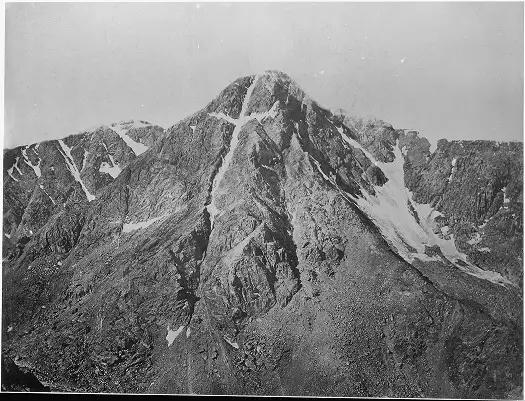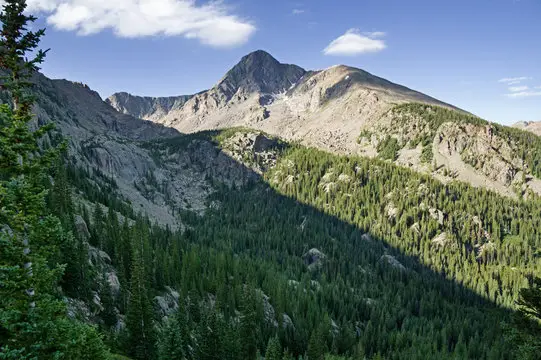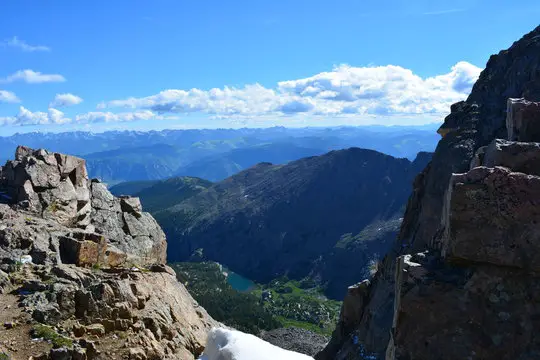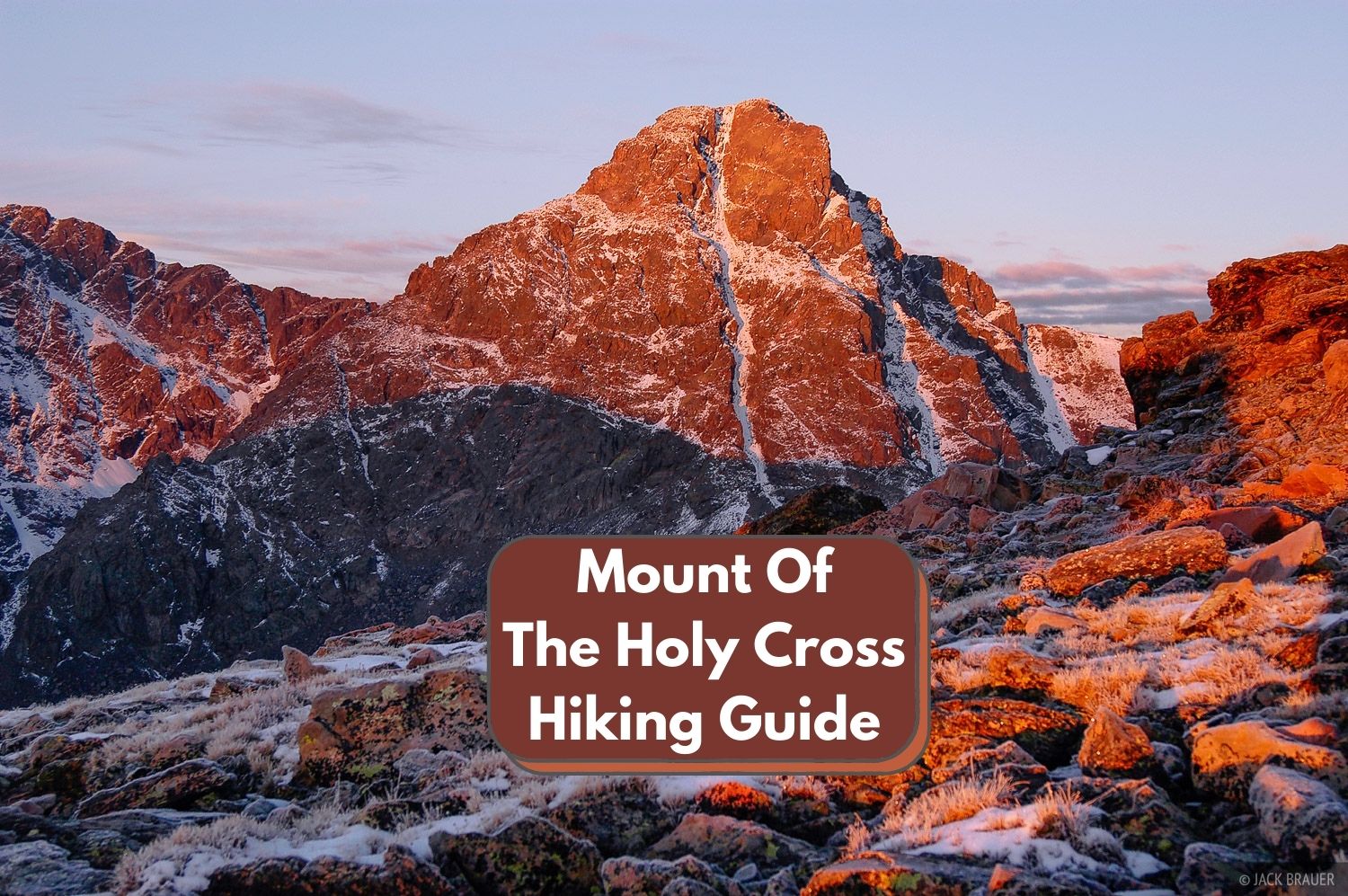If you’re looking for an epic hiking challenge, look no further than the Mount Of The Holy Cross.
This 14er is located in the Sawatch Range of the Rocky Mountains and offers a unique and rewarding experience for hikers of all levels.
In this Definitive Guide to Hiking the Mount Of The Holy Cross, we will provide everything you need to know before planning your hike.
We’ll discuss location, difficulty level, best times of year to hike, and what type of terrain to expect. Let’s get started!
Mount Of The Holy Cross

Mount Of The Holy Cross is one of 15 separate 14ers in the Sawatch Range that have over 300′ of elevation.
Location: The Mount Of The Holy Cross is located in the Sawatch Range of the Rocky Mountains, approximately 60 miles west of Denver.
The Sawatch Mountain Range – Home Of Mount Of The Holy Cross
The Sawatch Range is famous for it’s northern peaks that offer plenty of scrambling and mountaineering challenges for hikers, and features plenty of gorgeous mountain streams, lakes, and basins with plenty of greenery thanks to the extra snow this part of the range sees.
Difficulty Level
The hike to the summit of the Mount Of The Holy Cross is a strenuous 11.7 mile roundtrip Class II climb that requires some basic mountaineering skills. It’s important to be well-prepared for this hike and have proper equipment.
Elevation
Mount of the Holy Cross is one of the shortest 14ers, but what it lacks in distance it makes up in challenging terrain, gaining elevation quickly and requiring power from it’s travelers.
Starting elevation: 10,320 feet
Summit elevation: 14,005 feet
Best Time Of Year To Hike Mount Of The Holy Cross
Spring and summer are the best times of year to hike the Mount Of The Holy Cross, when conditions are most favorable.
However, it can be hiked year-round if you’re prepared for winter weather.
Mount Of The Holy Cross Terrain
There are three main types of terrain you’ll encounter on the hike to the summit of the Mount Of The Holy Cross: alpine tundra, subalpine forest, and scree.
Be prepared for a variety of conditions, depending on the time of year you hike.
Tips for Hiking the Mount Of The Holy Cross

Even if you’re an experienced hiker, it’s important to remember that hiking the Mount Of The Holy Cross is not a walk in the park.
You’ll need dedicated preparation beforehand and proper equipment during your hike (such as hiking boots with good ankle support).
It’s also imperative to pack enough water so stay hydrated throughout this strenuous climb!
Read more: the best ways to carry water while hiking.
You’re required to fill out a Wilderness Registration card for a self-issuing overnight permit.
You may want to bring along hiking poles to aid in stability for steep inclines and declines.
Check out our guide on what to wear hiking in fall so you have layers to cover you throughout the changing temperatures you’ll face while hiking Mount Of The Holy Cross.
Mount Of The Holy Cross Trailhead Access
The North Ridge is the best route to reach the summit of Mount of The Holy Cross, which can be accessed by climbing Half Moon Pass by way of Tigiwon Road.
Mount Of The Holy Cross Summit Route
Begin by hiking up Half Moon Trail to reach Half Moon Pass (about 1.5 miles).
The 13er Notch Mountain will be to your left.
Cross the pass and follow the trail west through a descent.
Near 11,300 feet, you’ll be able to see Holy Cross and other parts of the north ridge to the Southwest.
Continue over the shoulder of Notch Mountain, descending about 1,000 from Half Moon Pass to reach the forest area near East Cross Creek.
Cross over East Cross Creek, following the trail west through rocky areas, then continue south through the forest until you reach the tree line around 11,700 feet elevation.
Continue to follow the trail South/Southeast until you reach the ridge’s crest at around 12,100 feet.
Here you’ll find a trail that winds through talus marked by cairns to take you to the upper ridge at 13,400 feet.
Go left and continue on a rougher trail, which is where the terrain will become much more challenging.
You’ll get to a notch at the top of the Angelica Couloir, which is where the trail ends.
Here, you’ll proceed East up the last 300 feet to reach the summit of Mount Of The Holy Cross.
Descending Mount Of The Holy Cross

When descending from the summit, make sure you follow the same route back down to the North ridge.
Many hikers have become disoriented by not following the trail back down to East Cross Creek, leaving them waiting overnight for search and rescue.
Signage was added in the past few years to prevent this from happening so often.
Directions To Mount Of The Holy Cross
From I-70, take Exit 171 and proceed on U.S. Highway 24 through downtown Miniturn for approximately 5 miles, then turn right on to Tigiwon Rd.
The Half Moon Trailhead is about 9 miles down at the end of the dirt road.
Can I Bring Dogs On Mount Of The Holy Cross?
Dogs are allowed on leashes, but this is a challenging hike for humans, let alone pets. There’s no shade or water above the tree line, and the jagged scree can be tough on your pet’s paws. If you insist on bringing your dog along, make sure to bring plenty of water and consider some dog boots.
Camping at Mount Of The Holy Cross
Camping is available at the Half Moon Campground on a first come, first served basis, but there are only 11 campsites which fill up quickly.
Primitive camping is also an option on the trail near East Cross Creek at the end of the descent from Half Moon Pass (no campfires are allowed at primitive campsites here).
Wrapping Up Our Mount Of The Holy Cross Hiking Guide
The Mount Of The Holy Cross is an epic and challenging hike that offers a unique experience for hikers of all levels.
It’s important to be well-prepared before embarking on this journey, both physically and mentally.
With the proper equipment and preparation, you’re sure to have a rewarding experience climbing this 14er!
That’s all for now! We hope this guide has been helpful. Happy hiking!
While you’re here, check out our other helpful hiking guides:

